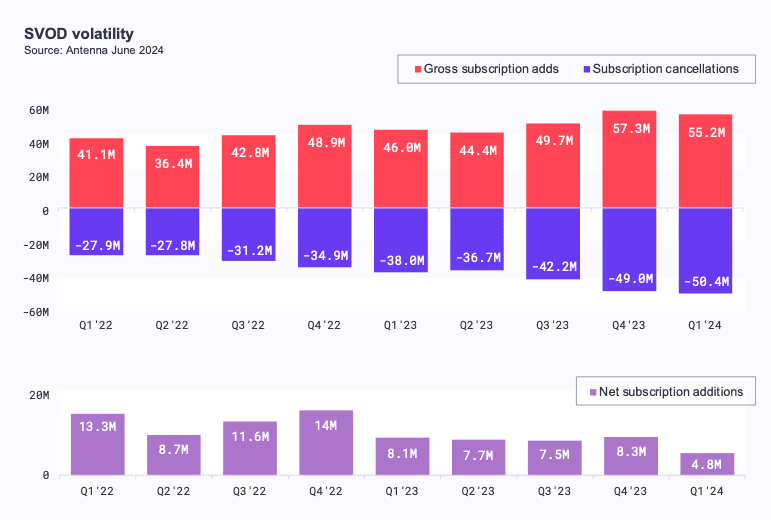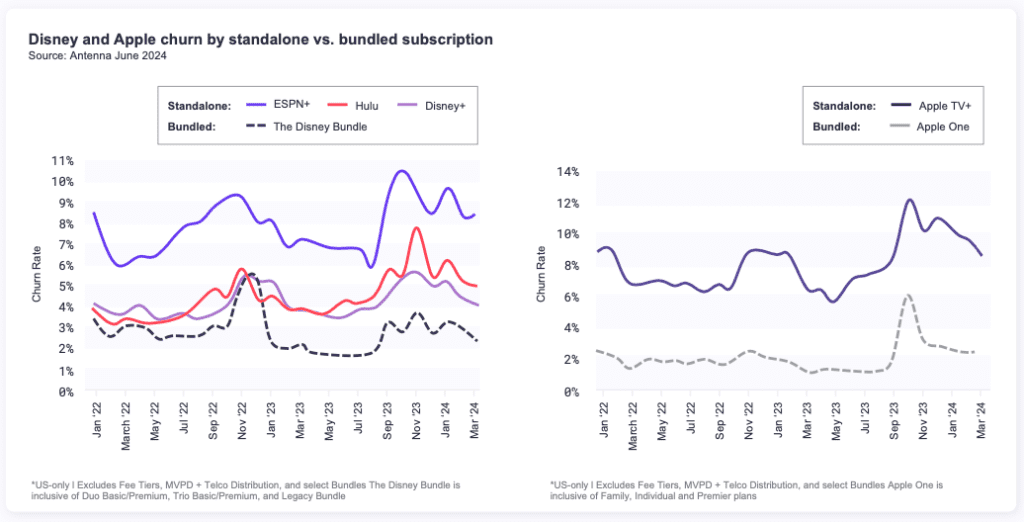The streaming industry has seen tremendous growth, but with this success comes new challenges. As platforms continue to raise prices, they face the growing issue of subscriber churn—the loss of subscribers who may no longer see value in their subscriptions. According to the latest Samba TV ‘State of Viewership’ report, the competitive landscape is becoming increasingly crowded, and consumer sensitivity to price hikes is at an all-time high. Streamers are now exploring various strategies to retain their audiences and minimize churn. This article explores these strategies and how they can be effectively implemented.
The Current Landscape: Streaming vs. Linear TV
The first half of 2024 has highlighted the ongoing shift from linear TV to streaming. While linear TV continues to decline with a 1% year-over-year drop in viewing hours, Over-the-Top (OTT) content consumption has surged by 40% over the same period. This significant increase emphasizes the need for streamers to address churn as competition for viewer attention intensifies.
Despite the widespread adoption of streaming, with 99 million U.S. households streaming content in the first half of 2024, subscription cancellations are on the rise. Data shows that while there were 55.2 million gross subscriber additions in Q1 2024, there were also 50.4 million cancellations, resulting in net additions of just 4.8 million. This reflects the volatility within the SVOD space. Moreover, the fact that 44% of these households watched only one or two platforms during this period indicates a growing trend of consumers becoming more selective about where they spend their money.
Recent developments at major media companies further emphasize the struggles of linear TV. Both Warner Bros. Discovery (WBD) and Paramount Global have announced significant write-downs on the value of their cable channels, collectively totaling $15 billion. WBD is writing down $9.1 billion on core networks such as TNT, TBS, Cartoon Network, and Discovery, while Paramount is slashing $6 billion from the valuation of networks like MTV, Paramount Network, and Comedy Central.
These moves signal a harsh reality that these channels are no longer worth as much as they used to be, primarily due to cord-cutting and the subsequent decline in advertising revenue. Cable has already lost substantial ground and viewers to streaming, rendering basic cable shows increasingly irrelevant in today’s culture.
These recent self-devaluations deepen the financial strain on traditional media companies in an already challenging economy. Although these impairment charges don’t directly impact cash flow, they have significantly weakened balance sheets, leaving few companies safe, aside from tech giants like Netflix, Amazon, and Apple.
This situation highlights the pressing need for traditional media companies to embrace streaming and deploy strategic solutions to address subscriber churn, critical to maintaining long-term stability in the rapidly evolving market.

Strategies to Combat Churn
Streamers are employing various strategies to combat churn, each tailored to the evolving needs and behaviors of their subscribers.
Bundling Offers
Bundling has emerged as a powerful tool in the fight against churn. Data from the first half of 2024 indicates that bundling services can significantly reduce churn rates. For example, subscribers to the Disney Bundle (including Disney+, Hulu, and ESPN+) are less likely to cancel than those subscribed to individual services. In March 2024, the churn rate for Apple TV+ as a standalone service was just under 9%, but for Apple One, which bundles multiple Apple services, the churn rate was less than 4%. Bundling offers more value to subscribers and strengthens their connection to the platform ecosystem, making it harder for them to cancel.

Ad-Supported Tiers
Ad-supported streaming options are increasingly popular as consumers seek ways to manage their entertainment costs. In the first half of 2024, ad-supported tiers accounted for over 50% of new SVOD sign-ups. Additionally, 33% of U.S. streamers watched Free Ad-Supported Streaming TV (FAST) services during this period. By offering lower-cost, ad-supported alternatives, streamers can appeal to price-sensitive consumers while still generating revenue through advertising. This strategy is particularly effective in retaining subscribers who might otherwise cancel due to rising costs.
Content Strategy and Release Schedules
Content remains a crucial factor in subscriber retention. However, the challenge lies in creating compelling content and releasing it in a way that maximizes viewer engagement. Data shows that many viewers watch only one original program per platform before canceling their subscription, highlighting the importance of having a robust content library and strategic release schedules.
For instance, Netflix has successfully reduced churn by engaging audiences with in-app and omni-screen promotions encouraging viewers to explore a broader range of content. Additionally, certain genres, such as docuseries and crime shows, have higher binge rates, with 50% and 47%, respectively, within the first five days of release. This suggests that streamers should consider these preferences when planning release schedules.
Re-Engaging Subscription Cyclers:
One of the challenges streamers face is the phenomenon of subscription cycling, where users hop between platforms, canceling and resubscribing based on content availability. To address this, platforms must focus on re-engaging these cyclers by offering exclusive, high-demand content that draws them back. Shows like “Ted,” “Masters of the Air,” and “Shōgun” have been particularly successful in this regard, driving viewers to return to platforms they had previously abandoned. In fact, 66% of H1 2024 platform viewers who had not watched platform originals in the previous six months returned to engage with these buzzy new shows.
The Take
Managing churn will remain a critical focus as streaming services continue to raise prices. Strategies such as bundling, ad-supported tiers, strategic content release, and re-engagement are all essential in retaining subscribers. However, the future of churn management will likely see even more sophisticated approaches, with AI and machine learning playing a central role in predicting subscriber behavior and optimizing retention efforts.
While price increases are inevitable, they don’t have to result in higher churn if streamers are proactive in implementing strategies that enhance the value of their services. By understanding and addressing the needs of their subscribers, streamers can maintain a loyal audience even as they navigate the complexities of a competitive and ever-changing market. The ability to adapt and innovate in response to these challenges will determine the long-term success of these platforms in an increasingly saturated market.







